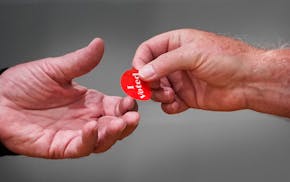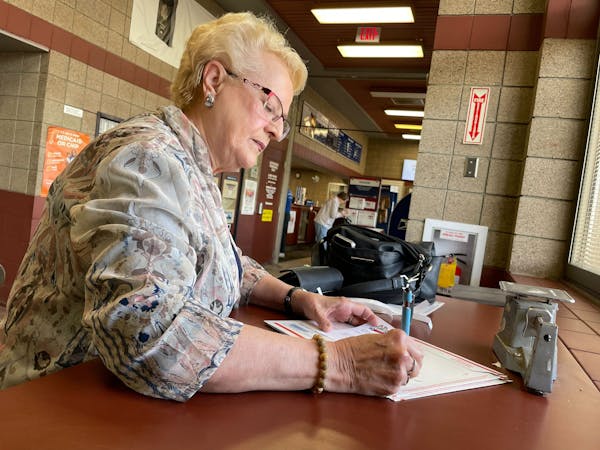When we #stayhome to #staysafe the implication is that it's not safe away from home. Yet many states are beginning to relax restrictions designed to #reducethespread, with more to come. Maybe even, one day, Minnesota, where Gov. Tim Walz extended a statewide stay-home order Thursday.
But even low-risk individuals tell me they are reluctant to buy in without the surety of a vaccine.
This is where the government and media messaging of the last eight weeks comes crashing into the new reality of the pandemic. Those two institutions spent March and April scaring the crap out of us to protect America's hospital systems from a surge predicted by virus modeling. It was a reasonable approach in the knowledge vacuum the world faced.
But all our wise men, from Anthony Fauci to Michael Osterholm, have subsequently told us this is a long game and our tactics need to evolve. Now that our medical system is nearly prepared, that time is nigh.
In essence, we stayed home to protect the system, and now we have to venture forth to protect the consumer economy and its disproportionately small-business, low-wage and immigrant workforce.
Gov. Walz himself says lockdowns are not a long-term solution. Yet the social-media chatter is just as shrill as it was before we flattened the curve: Stay home or you will kill all of us!
Here's the harsh reality no elected official seems willing to state: Over the coming 18 months, most of us will acquire the virus. Some of us will get sick, but very few of us will die. Government builds acceptable rates of loss into all sorts of things, from freeway design to flu modeling and fire department staffing. A pandemic is no exception.
And before you tweet: I have elderly parents and my profession is in economic free fall. I want to keep as many of both alive as possible.
Let's look at the data as of Thursday: Minnesota had seen 1,044 hospitalizations, 343 COVID-19 fatalities and 5,136 verified cases. Health Commissioner Jan Malcom has estimated there are likely 100 times that many actual cases circulating in the populace. For argument, let's call it 50 times.
That's 256,800 cases, which works out to a hospitalization rate of 0.41% and a case fatality rate of 0.13%, not the 7% fatality figure we now have by testing only the sickest.
So the urgent issue for America is getting the message out about who is at risk of serious health impacts and who isn't, which behaviors are risky and which aren't. I'm not talking about rare outlier outcomes (the COVID equivalent of getting hit by a bus), but common ones.
But the messaging remains chaotic, as Walz reopens workplaces while the Minneapolis Park and Recreation Board closes tennis courts.
There is a lot of credible information out there, two months in, to reassure many of us. But we need to get beyond empiricists unwilling to offer nuanced guidance in an evolving situation. It's smart to wait for double-blind studies on vaccines and drugs. But not on how the virus is commonly or atypically spread. We can't let the perfect be the enemy of the good.
There is a growing body of data that the virus is not spread as someone passes you on the walking path, or in short conversations from 6 feet away in your office. Data from so-called super-spreader events, where dozens or hundreds were infected, point to unmasked close proximity for an extended period.
But the media's preoccupation with outlier stories and apocalyptic scenarios make even people at minuscule risk justifiably nervous. A very fit (and smart) 50-something friend told me recently he had polled a small group of peers and none were willing to enter a restaurant again until a vaccine is widely available. People are assessing risk in idiosyncratic ways, often with last month's information, or based on emotional reactions to anecdotal stories.
My progressive friends who are not scared for themselves alternately suggest they will boycott restaurants and retail to protect its employees. Well, that's your choice, but it's not your suffering. Great Depression levels of unemployment will surely produce millions of dire health outcomes.
Maybe instead we should wear our masks, wash our hands, keep our distance, assess the real risks and resume our lives.
Listen to Osterholm — we have to learn to coexist with COVID-19. That means it's incumbent on state and federal government (via the scientific community) to offer clearer messaging about the virus and public safety for those at low or moderate risk. (For example, asthmatics were told they were at high-risk, but asthma has not been a highly ranked comorbidity in U.S. deaths.)
Right now there are millions of jobless or soon-to-be jobless Americans hoping that better data about the virus reach you and me so that when they go back to waiting tables, prepping exam rooms, cleaning hotels and cutting hair, there will be customers to pay their salaries.
I believe that information is out there. Hopefully our minds are open enough to hear it.
Adam Platt is executive editor of Twin Cities Business magazine.
For Mother's Day, I don't want brunch. We need a cease-fire.



